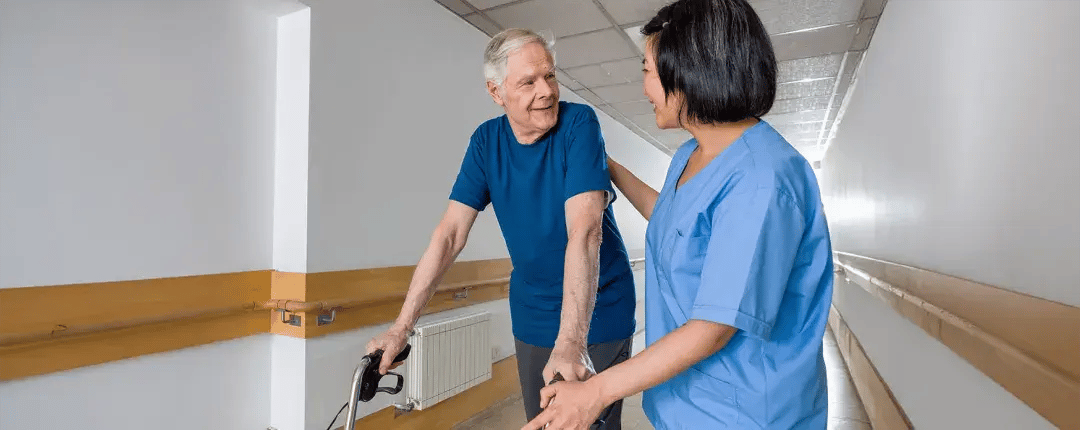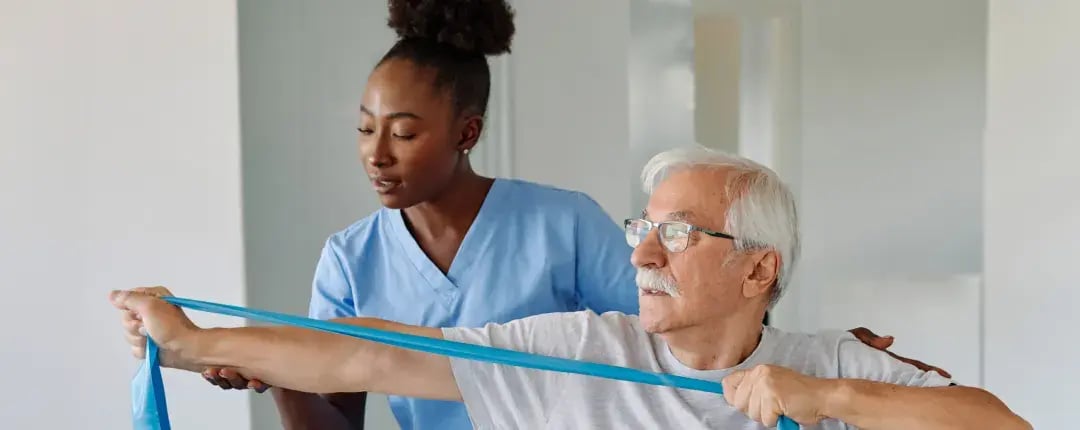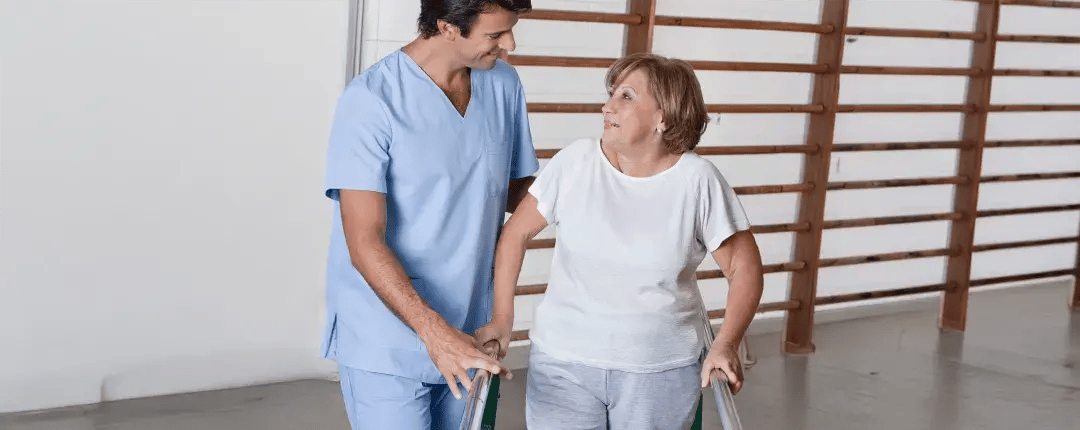
At some point, you or someone you love may need short-term care to regain mobility or rebuild wellness while dealing with a chronic condition or after an acute incident, injury, or procedure. No matter your age or health status, short-term rehabilitation can make a measurable difference — and often-cited research shows physical therapy alone can lead to successful outcomes in around 70% of cases.
This guide explores what short-term care involves, why it’s often essential for lasting improvement, the types of services offered, how to choose the right facility, and what to expect as you transition back home.
If you’re recovering from surgery, illness, or an injury, your doctor may suggest a short-term rehabilitation program to help you regain stamina, restore mobility, and make a safe return home.
Short-term care offers intensive therapy, around-the-clock clinical support, and medication management in a specialized environment for patients who’ve left the hospital but still need focused rehabilitation before returning to their daily routines. Each person follows a customized care plan to enhance movement, reduce pain, and regain confidence in their physical abilities.
The best short-term rehabilitation programs share four key qualities that drive successful recovery outcomes:
Experts across nursing, therapy, and medical disciplines collaborate to create a holistic, adaptive short-term care experience.
Structured programs — typically up to three hours per day, five days a week — help patients rebuild endurance, increase flexibility, and reduce complications.
Personalized goals ensure each patient’s therapy aligns with their condition, progress, and lifestyle needs.
Innovative tools like robotic-assisted movement systems and real-time tracking support better engagement and measurable progress.
Ultimately, short-term care unites expert clinical guidance, advanced technology, and compassionate support to help patients regain vitality and return home feeling prepared and self-assured.
Moving from a hospital stay to recovery at home can be one of the most challenging parts of the healing process. Transitional care in a short-term rehabilitation setting bridges that gap, addressing a patient’s medical, functional, and emotional needs and ensuring they’re safely building strength, mobility, and confidence before returning home. While rehabilitation focuses primarily on functional recovery, transitional care combines medical supervision, physical and occupational therapy, medication management, and emotional support to ensure care continuity between hospital and home — reducing readmissions and improving recovery outcomes.
For many patients entering a short-term rehabilitation facility, care is first focused on rebuilding the strength of vital systems — the lungs, heart, and brain — to restore endurance, resilience, and overall well-being.
While every patient’s needs will vary, there are a few things everyone should know about short term care. Fill out the form to download our free guide to take charge of your own recovery today.
Click a link to go directly to a specific section.

During recovery, the body’s most vital systems — the heart, lungs, and brain — often need focused rehabilitation to improve endurance, circulation, and cognitive function. Short-term care provides the structure, therapy, and medical oversight patients need to rebuild these core systems safely and effectively.
Through personalized exercise programs, respiratory therapy, cardiac conditioning, and cognitive rehabilitation, patients in short-term care can expand breathing capacity, improve cardiovascular health, and enhance memory and focus. These therapies not only accelerate recovery from acute events but also support long-term wellness and independence once you return home.

Respiratory care helps patients recover from illnesses, surgeries, and chronic conditions that affect breathing and lung function. This specialized therapy supports faster healing, greater comfort, and an easier move back home.
Respiratory care is different from long-term respiratory rehab, which manages chronic lung diseases over time.
Patients recovering from:

After a heart attack or other cardiac event, many patients aren’t ready to return home right away. Cardiac rehab in a short-term care facility supports the next part of their journey, providing an established routine, medical supervision, and therapy needed to restore strength and confidence safely.

Stroke rehab plays a crucial role in helping survivors regain movement, communication, and confidence after a stroke. The right program provides the medical expertise, therapy intensity, and emotional support needed to rebuild function and prevent complications.
Choosing the right stroke rehab program depends on each survivor’s health, mobility, and recovery goals. A structured, multidisciplinary approach — especially in an inpatient setting like the short-term programs Rehab Select offers — can dramatically enhance outcomes, restore independence, and improve quality of life.

A well-defined Parkinson’s disease care plan helps patients maintain independence, mobility, and quality of life while managing a progressive neurological condition. Short-term rehabilitation adds vital, time-limited support — especially after a change in health status or hospitalization — through intensive, multidisciplinary therapy.
Integrating short-term rehabilitation into a Parkinson’s disease care plan helps patients remain active, emotionally resilient, and socially engaged. With coordinated therapies and comprehensive support, short-term rehab reinforces long-term stability — helping individuals live more comfortably and confidently with Parkinson’s disease.

Recovering from an injury, accident, or surgical procedure often requires more than rest — it calls for targeted rehabilitation to restore movement, confidence, and strength. Short-term care provides the specialized setting, medical expertise, and therapy patients need to heal safely and reclaim their independence.
For those recovering after surgery, short-term care is a vital continuation of healing once a hospital stay ends. A structured post-surgery rehabilitation program focuses on regaining mobility, improving flexibility, and preventing complications like stiffness, infection, or blood clots. Therapists work closely with patients to rebuild function, manage pain, and help them return to daily activities with greater confidence. Emotional and psychological support also play a central role, ensuring that rehab strengthens both body and mindset.
Likewise, patients recovering from accidents or injuries benefit from the same level of coordinated, around-the-clock support. In these cases, short-term rehab combines intensive therapy with continuous medical monitoring to help patients recover safely and efficiently. Individualized care plans may include physical, occupational, or cognitive therapy designed to rebuild coordination and endurance, while medical staff manage pain and monitor healing progress. By preparing patients for daily routines and home life, short-term rehab helps them move forward with better physical capabilities, stability, and peace of mind.

Recovering from knee surgery requires an active, informed approach. Rehab after knee surgery helps patients regain stability, restore motion, and rebuild confidence in daily life. But the most successful recoveries don’t just happen in therapy sessions — they start with preparation, commitment, and the right environment for healing.
A post-surgery program usually begins within 24 hours of your procedure. Early rehab focuses on gentle movement to reduce swelling and stiffness before progressing to more advanced exercises that enhance flexibility, coordination, and balance.
A complete program may include:
Each plan is customized based on the type of surgery, your health, and recovery goals — ensuring that progress feels achievable, not overwhelming.
Recovery begins before the first incision. Many orthopedic programs offer pre-surgery education to help patients understand what’s ahead and practice exercises that condition the body for success. Simple steps like improving flexibility, adjusting nutrition, and reducing stress make the post-surgery phase more manageable. A calm, prepared mindset supports faster recovery and smoother transitions into therapy.
Consistency is the cornerstone of rehab after knee surgery. A structured, short-term rehabilitation program provides daily, supervised therapy sessions that reinforce progress and reduce complications. Staying engaged, by attending sessions, communicating openly with your therapists, and following exercises at home, ensures steady improvement.
Even after discharge, commitment continues. Follow-up appointments, home exercise routines, and outpatient therapy sustain momentum and help prevent setbacks.
Your home can make or break your recovery experience. Before discharge, prepare a safe, supportive environment by:
Facilities like Rehab Select involve family members in discharge planning so that your home supports your therapy goals and minimizes stress during the adjustment period.

Joint replacement recovery is where lasting movement, balance, and independence begin to take shape. With the right preparation, care, and consistency, you can ease pain, avoid complications, and return to the activities you love sooner.
After surgery, your body begins adjusting to the new joint while healing surrounding tissues. Joint replacement recovery typically includes:
Most patients regain mobility within six to 12 weeks, but your timeline depends on your overall health, type of surgery, and commitment to the plan.
Recovery starts before you even enter the operating room. Research and select a short-term care facility that offers intensive, hands-on rehabilitation and around-the-clock clinical oversight. A proactive plan minimizes stress and ensures a seamless transition from hospital to therapy.
Look for programs with daily physical therapy sessions, pain management support, and a coordinated team that tailors care to your specific surgery and recovery goals.
Set yourself up for success by improving your health before surgery. Pre-surgery “prehab” exercises can strengthen surrounding muscles and joints, giving you a stronger foundation for recovery. Pair this with nutrient-rich meals that boost energy, immunity, and tissue repair.
If you have chronic conditions like diabetes or hypertension, work with your doctor to stabilize them beforehand — this step alone can significantly reduce post-surgical complications.
Knowledge builds confidence. Understanding your procedure and what to expect from joint replacement recovery helps you stay engaged and motivated throughout each stage. Attend pre-surgery education sessions, ask your surgeon questions, and involve family members in care planning.
A safe, organized space supports independence and reduces setbacks. Prepare your home by:
Even if you complete initial recovery in a short-term facility, preparing your home ensures a smoother, safer return to daily life.

Hip replacement surgery restores comfort and mobility, but the real transformation happens afterward. A structured hip replacement rehab program helps patients recondition supporting muscles, improve balance, and shorten recovery time while lowering the risk of complications.
Rehab usually begins within 24 hours of surgery under the guidance of physical therapists and medical staff. Early sessions focus on circulation and gentle range-of-motion work; as healing progresses, therapy expands to walking practice, targeted strength training, and real-life mobility tasks.
Whether completed in a hospital, inpatient center, or outpatient clinic, success in hip replacement rehab depends on three factors: consistency, individualized planning, and active participation.
Supervised motion soon after surgery jump-starts circulation, reduces swelling, and prevents stiffness. Even simple ankle pumps or assisted walks can make a measurable difference.
Tip: Follow your therapist’s lead. Small, frequent movements early on set the stage for faster gains later.
After a hip replacement, surrounding muscles must relearn how to stabilize and protect the new joint. Rehab targets the hips, thighs, and core to rebuild strength, restore alignment, and improve balance.
Tip: Focus on controlled repetitions and proper form. Communicate discomfort early so your team can adjust exercises before minor issues slow progress.
Hip replacement rehab is about more than exercise; it’s about returning to normal life. Therapists teach safe ways to perform everyday activities like standing from a chair, climbing stairs, or getting into a car.
Tip: Practice functional tasks during therapy and at home to regain confidence and efficiency in your movements.
Moving too quickly or incorrectly can stall recovery. A guided program helps you progress at the right pace while correcting risky habits early.
Tip: Observe weight-bearing restrictions and avoid sudden twisting or bending. Consistent communication with your therapists keeps healing on track.
Recovery is as much psychological as physical. Structured rehab provides milestones, motivation, and accountability that keep spirits high when progress feels slow.
Tip: Celebrate small wins, set achievable weekly goals, and lean on your care team for encouragement — they’re invested in both your physical and emotional recovery.

Family caregivers are the backbone of long-term care in America. According to the US Census Bureau, more than 50 million people provide daily support for aging parents, loved ones with disabilities, or individuals recovering from illness or injury. While the role is rewarding, it’s also physically, emotionally, and mentally demanding. Without time to rest, caregivers face fatigue, stress, and even burnout — ultimately impacting both their well-being and the quality of care they provide.
That’s where respite care services come in. These programs offer temporary, short-term relief for caregivers while ensuring their loved ones receive high-quality, supervised care in a safe, supportive environment. Whether for a weekend, a few hours, or a weeklong stay, respite care allows caregivers to recharge while patients continue to receive the personalized attention they need.
Respite care services are flexible, designed to fit each family’s situation and level of care needed. Options may include:
Each approach ensures the person receiving care remains safe, socially connected, and well-supported while the caregiver steps away.
A trusted respite care provider benefits both the caregiver and the patient in meaningful ways:
Choosing the right respite care provider starts with planning ahead before burnout sets in. Here’s what to consider:
Ultimately, short-term care and respite care services share the same goal: to restore balance and peace of mind for both patient and caregiver. When the right respite care provider is in place, families gain relief and contentment, knowing their loved one’s needs are being well-met.
As you explore your options, understanding how to choose the right short-term care facility becomes the next step in building a sustainable care plan.

After surgery, illness, or injury, selecting the right short-term care facility is one of the most important decisions in your recovery journey. The right environment can make the difference between a slow, uncertain recovery and one that’s smooth, safe, and confidence-building.
Each patient’s needs are unique, but the goal is the same: to return home stronger and ready for independence. The best short-term rehab facilities help you reach that goal through skilled therapy, attentive care, and a supportive environment designed for healing.
Start by ensuring the facility meets national and state standards. Accreditation from organizations such as The Joint Commission or the Commission on Accreditation of Rehabilitation Facilities (CARF) signals high-quality care, safety, and a commitment to continuous improvement. State licensing and Medicare/Medicaid certification are also key indicators of credibility.
Reading recent reviews and testimonials can also give you insight into staff responsiveness, cleanliness, and overall patient satisfaction.
Your recovery depends on both expertise and empathy. A well-staffed short-term rehab facility employs licensed nurses, therapists, and physicians who specialize in your condition — from cardiac to orthopedic rehabilitation.
Ask about staff-to-patient ratios and how the care team collaborates. Facilities that foster teamwork and maintain lower ratios can provide more attentive, coordinated, and consistent care throughout your stay.
Rehabilitation goes beyond physical therapy. The best short-term care facilities provide whole-person care, addressing medical, emotional, and functional needs. Look for facilities that offer integrated services such as:
This multi-faceted approach helps patients regain independence, confidence, and quality of life, both during their stay and after discharge.
Every recovery journey is different. Choose a short-term rehab facility that provides targeted programs for your specific condition, such as:
These condition-specific programs ensure you receive focused, evidence-based care that accelerates progress and reduces the risk of complications.
Healing happens best in an environment that’s both safe and uplifting. The ideal short-term care facility maintains a clean, well-lit space with safety features like non-slip floors, handrails, and accessible therapy areas.
Beyond safety, comfort matters — bright, welcoming spaces, access to recreation or quiet lounges, and natural light all contribute to a positive mindset that supports faster healing.
A nearby short-term rehab facility makes it easier for family and friends to visit — an important motivator during recovery. Consider parking, wheelchair access, and the overall layout to ensure you can move freely and comfortably throughout the facility.
The best facilities think beyond discharge. Ask about post-rehab planning and follow-up services, such as outpatient therapy or home safety assessments. A short-term care facility that coordinates next steps ensures you transition home with confidence, reducing the risk of readmission or setbacks.
While many patients use Medicare, Medicaid, or private insurance to cover part or all of their stay, out-of-pocket expenses vary. Factors influencing cost include:
Before admission, request a transparent cost breakdown. Reputable facilities will help you understand coverage, copays, and payment options, ensuring no surprises later.
If the process feels overwhelming, you’re not alone. Your healthcare provider, hospital discharge planner, or social worker can help identify trusted facilities that fit your medical and financial needs.
You can also use Medicare’s online comparison tool to evaluate ratings and compliance reports for short-term care facilities near you. And don’t underestimate the power of personal recommendations — friends and family who’ve experienced rehabilitation firsthand can often provide the most honest insights.

Leaving a short-term care facility marks a major milestone, but the transition home can be one of the most delicate parts of recovery. After weeks of round-the-clock care, structured therapy, and support, the shift to independence can feel both exciting and overwhelming. With the right preparation and follow-through, you can maintain the progress you’ve made in your short-term rehab facility and continue building strength, safety, and confidence at home.
The best time to plan for discharge is well before you leave the short-term rehab facility. Work with your care team — including physical and occupational therapists, nurses, and discharge planners — to identify what you’ll need for a safe transition. This may include assistive equipment, medication management, and continued outpatient therapy.
If possible, ask whether a therapist can visit your home before discharge to evaluate safety and accessibility. Having these details in place early ensures you return to an environment that supports continued healing.
Progress doesn’t stop once you leave the facility, but it often happens in smaller, incremental steps. Setting short-term, achievable goals helps maintain motivation and prevent frustration. Collaborate with your rehab team to outline what success looks like in the first few weeks back home, whether that’s walking a certain distance, climbing stairs independently, or completing daily tasks without assistance.
Before returning home, make modifications that reduce fall risks and promote independence:
Simple touches — like softer lighting, soothing scents, or comfortable seating — can also help recreate the calm, healing atmosphere of your short-term care facility at home.
Recovery is a team effort. Family, friends, neighbors, and local organizations can all play a role in helping you succeed after you return home. Ask your rehab facility’s social worker about community services like:
Having these supports in place gives you practical help and emotional reassurance — two key ingredients for a smooth transition.
Even after discharge, your healthcare providers remain essential partners in your recovery. Schedule follow-up appointments before leaving the short-term rehab facility and keep a simple journal to track progress, pain levels, and new symptoms. Sharing these notes helps your doctors and therapists fine-tune your care plan and address concerns quickly.
Finally, remember that no one knows your recovery journey better than you do. Speak up if something doesn’t feel right, whether it’s medication side effects, unclear instructions, or physical challenges. Communicating openly with your care team ensures that your recovery stays safe, effective, and aligned with your goals.
If you’re ready to talk with someone about your short-term care needs, reach out to Rehab Select to discover if one of our five facilities in Alabama might be a good fit for you or a loved one.
Short-term care focuses on rehabilitation and recovery following surgery, injury, or illness, usually lasting days to weeks. Long-term care supports chronic health needs over months or years.
Patients recovering from orthopedic surgery, cardiac events, respiratory illness, neurological conditions, or extended hospital stays.
In many cases, yes — particularly when medically necessary after a qualifying hospital stay. Coverage varies by plan, so it’s important to confirm details in advance.
Look for licensed, accredited programs offering individualized therapy, compassionate staff, and post-discharge support.
Patients often continue outpatient therapy or home-based exercises while staying connected with their care team to ensure continued progress.
Rehabilitation (Rehab):
A structured process of therapy and medical care that helps restore physical and cognitive function after injury, illness, or surgery.
Transitional Care:
Support provided between hospital discharge and home recovery to ensure continuity of medical supervision and therapy.
Occupational Therapy (OT):
Therapy that helps patients relearn daily activities and adapt to physical or cognitive limitations.
Physical Therapy (PT):
Exercise- and movement-based therapy that improves mobility, strength, and endurance.
Respite Care:
Temporary, short-term care that allows family caregivers to rest while ensuring their loved one receives professional supervision and support.
Multidisciplinary Team:
A coordinated group of healthcare professionals, including nurses, physicians, and therapists, who work together to guide a patient’s recovery plan.
Activities of Daily Living (ADLs):
Routine self-care tasks like dressing, bathing, and eating that are often part of rehabilitation goals.
